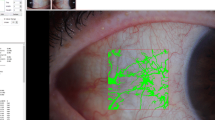Abstract
Long-term use of topical drugs can induce changes in theconjunctiva and ocular surface. To determine theconjunctival changes resulting from topical glaucomamedication, patients with glaucoma were selected andclassified into seven groups, according to the medicationreceived: 24 eyes were treated with betaxolol, 20 eyes withlevobunolol, 32 eyes with timolol maleate, 22 eyes withpilocarpine, 52 eyes with beta-blocker and pilocarpine, 34eyes with beta-blocker and dipivefrin, and 32 eyes withmaximum therapy. Patients who were under 18 wereexcluded, as were those with any history of ocular surgeryand other interventions, long-term use of any topicallyadministered medication except glaucoma drugs, and anyhistory or slit-lamp examination evidence of ocular surfacedisorders. The changes in the conjunctiva of 216 eyes wereevaluated by means of ocular surface impression cytology.The medication group showed statistically significant degreesof conjunctival metaplasia when compared to the controlgroup (p < 0.01). The cytological grading was not correlatedwith age, sex, type of medication, duration of topicaltreatment or the number of drugs (p > 0.05). Duration oftreatment exceeding three months was not correlated withcytological grading. Thus, as far as surgical treatment wasconcerned, it was concluded that intervention within the firstthree months after the diagnosis would be most beneficial inthe management of glaucoma.The fact that the presence of the preservative benzalkoniumchloride was the same in all preparations suggests that itmay be the major factor in conjunctival metaplasia.
Similar content being viewed by others
References
Tseng SCG, Hirst LW, Maumene AE, Kenyon KR, Sun TT, Green WR. Possible mechanisms for the loss of goblet cells in musin deficient disorders. Ophthalmology 1984; 91(6): 545–52.
Patten JT, Cavanagh HD, Allansmith MR. Induced ocular pseudopemphigoid. Am J Ophthalmol 1976; 82(2): 272–6.
Fiore PM, Jacops IH, Goldberg DB. Drug induced pemphigoid a spectrum of diseases. Arch Ophthalmol 1987; 105: 1660–3.
Lavin MJ, Wormald RP, Migdal CS, Hitchings RA. The influence of prior therapy on the success of trabeculectomy. Arch Ophthalmol 1990; 108: 1543–8.
Young TL, Higginbottham EJ, Zou X, Farber MD. Effects of topical glaucoma drugs on fistulized rabbit conjunctiva. Ophthalmology 1990; 97(11): 1423–7.
Burstein NL. The effects of topical drugs and preservatives on the tears and corneal epithelium in dry eye. Trans Ophthalmol Soc UK 1985; 104: 402–9.
Lemp MA, Zimmerman LE. Toxic endothelial degeneration in ocular surface disease treated with topical medications containing benzalkonium chloride. Am J Ophthalmol 1988; 105: 670–3.
Egberg PR, Lauber S, Maurice DM. A simple conjunctival biopsy. Am J Ophthalmol 1977; 84(6): 798–801.
Nelson JD, Havener VR, Cameron JD. Cellulose acetate impressions of the ocular surface, dry eye states. Arch Ophthalmol 1983; 101: 1869–72.
Sherwood MB, Midgal CS, Hitchings RA, Sharir M, Zimmerman TJ, Schultz JS. Initial treatment of glaucoma: Surgery or medications. Survey Ophthalmol 1993; 37(4): 293–305.
Coakes RL, Mackie IA, Seal DV. Effects of long term treatment with timolol on lacrimal gland function. Br J Ophthalmol 1981; 65: 603–5.
Aberg G, Adler G, Wikberg J. Inhibition and facilitation of lacrimal flow by b-adrenergic drugs. Acta Ophthalmol 1979; 57: 225–35.
Nielsen NV, Ericsen JS. Timolol transitory manifestations of dry eyes in long term management. Acta Ophthalmol 1979; 57: 418–24.
Paschides CA, Petroutsos G, Psilas K. Correlation of conjunctival impression cytology results with lacrimal function and age. Acta Ophthalmol 1991; 69: 422–5.
Herreras JM, Pastor JC, Calonge M, Asensio VM. Ocular surface alteration after long-term treatment with an antiglaucomatous drug. Ophthalmology 1992; 99(7): 1082–8.
Kramer P, Lupkin V, Potter W, Jacobs M, Labay G, Silverman P. Cyclic changes in conjunctival smears from menstruating females. Ophthalmology 1990; 97(3): 303–7.
Lemp MA:General measures in management of the dry eye. Int Ophthalmol Clin 1987; 27(1): 36–43.
Abdel-Khalek LMR, Williamson J, Lee WR. Morphological changes in the human epithelium. I. In the normal elderly population. Br J Ophthalmol 1978; 62: 792–9.
Johnson DH, Kenyon KR, Epstein DL, Buskirk EMV. Corneal changes during pilocarpine gel therapy. Am J Ophthalmol 1986; 101: 13–5.
Liesegang TJ. Bulbar conjunctival follicles associated with dipivefrin therapy. Ophthalmology 1985; 92(2): 228–33.
Derous D, Keizer JW, Wolff-Rouendaal D, Soudijn W. Conjunctival keratinisation, and abnormal reaction to an ocular beta-blocker. Acta Ophthalmol 1989; 67: 333–8.
Steuhl K-P. Ultrastructure of the conjunctival epithelium. Dev Ophthalmol 1989; 19: 1–104.
Brandt JD, Wittpenn JR, Katz LJ, Steinmann WN, Spaeth GL. Conjunctival impression cytology in patients with glaucoma using long-term topical medication. Am J Ophthalmol 1991; 112: 297–301.
Sherwood MB, Grierson I, Millar L, Hitchings RA. Long-term morphologic effects of antiglaucomatous drugs on the conjunctiva and tenon capsule in glaucoma patients. Ophthalmology 1989; 96: 327–35.
Strempel I. Immediatwirkung topischer Beta-Blocker auf die ‘Breakup time’. Ophthalmologica 1986; 192: 11–6.
Broadway DC, Grierson I, O’Brien C, Hitchings RA. Adverse effects of antiglaucoma medications. I. The conjunctiva cell profile. Arch Ophthalmol 1994; 112: 1437–45.
Gasset AR, Ishii Y, Kaufman HE, Miller T. Cytotoxicity of ophthalmic preservatives. Am J Ophthalmol 1974; 78: 98.
Nelson DJ, Farris RL. Sodium hyaluronate and polyvinyl alcohol artificial tear preparations, a comparison in patients with keratoconjunctivitis sicca. Arch Ophthalmol 1988; 106: 484–7.
Baudouin C, Garcher C, Haouat N, Bron A, Gastuat P. Expression of inflammatory membrane markers by conjunctival cells in chronically treated patients with glaucoma. Ophthalmology 1994; 101(3): 454–60.
Author information
Authors and Affiliations
Rights and permissions
About this article
Cite this article
Turaçli, E., Budak, K., Kaur, A. et al. The effects of long-term topical glaucoma medication on conjunctival impression cytology. Int Ophthalmol 21, 27–33 (1997). https://doi.org/10.1023/A:1005892426045
Issue Date:
DOI: https://doi.org/10.1023/A:1005892426045




